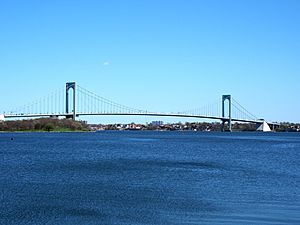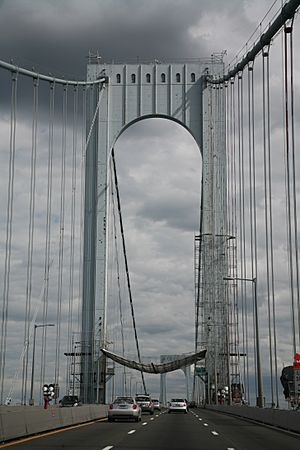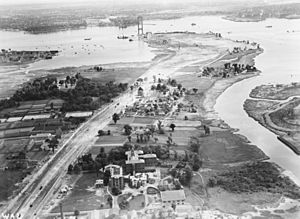Bronx–Whitestone Bridge facts for kids
Quick facts for kids Bronx–Whitestone Bridge |
|
|---|---|

View of the Bronx–Whitestone Bridge from Clason Point Park on the Bronx side
|
|
| Coordinates | 40°48′04″N 73°49′45″W / 40.80111°N 73.82917°W |
| Carries | 6 lanes of |
| Crosses | East River |
| Locale | New York City (Throggs Neck, Bronx – Whitestone, Queens) |
| Other name(s) | Whitestone Bridge |
| Maintained by | MTA Bridges and Tunnels |
| Characteristics | |
| Design | Suspension bridge |
| Total length | 3,770 feet (1,150 m) |
| Longest span | 2,300 feet (700 m) |
| Clearance above | 14 feet 6 inches (4.4 m) |
| Clearance below | 134 feet 10 inches (41.1 m) |
| History | |
| Construction cost | $17.5 million |
| Opened | April 29, 1939 |
| Statistics | |
| Daily traffic | 124,337 (2016) |
| Toll | As of March 31, 2019, $9.50 (Tolls By Mail and non-New York E-ZPass); $6.12 (New York E-ZPass) |
The Bronx–Whitestone Bridge, often called the Whitestone Bridge, is a suspension bridge in New York City. It carries six lanes of Interstate 678 over the East River. This important bridge connects Throggs Neck and Ferry Point Park in the Bronx with the Whitestone neighborhood in Queens.
Even though people thought about building this bridge as early as 1905, it wasn't approved until 1936. The famous Swiss-American architect Othmar Ammann designed it. The bridge first opened on April 29, 1939, with four lanes for cars.
Its original design was similar to the Tacoma Narrows Bridge, which sadly collapsed in 1940. Because of this, extra strong supports called stiffening trusses were added to the Bronx–Whitestone Bridge in the early 1940s. At the same time, it was made wider to have six lanes.
The bridge has been updated several times. From 1988 to 1991, parts that hold the cables (anchorages), roads, and drainage were fixed. In the mid-2000s, the stiffening trusses were removed, and the bridge's road surface and connecting roads were replaced.
The Bronx–Whitestone Bridge is owned by New York City and managed by MTA Bridges and Tunnels. This agency is part of the Metropolitan Transportation Authority. The main part of the bridge, called the center span, is 2,300 feet (700 m) long. For a while, it was the fourth-longest center span of any suspension bridge in the world. The entire bridge is about 3,700 feet (1,100 m) long, and its tall towers reach 377 feet (115 m) above the water.
Contents
How the Bridge is Built
The Bronx–Whitestone Bridge has a main span of 2,300 feet (700 m) between its two tall towers. This part of the bridge rises 150 feet (46 m) above the water. The sections on either side of the main span, between the towers and the anchorages, are 735 feet (224 m) long. This means the total length of the bridge from one end to the other is 3,770 feet (1,150 m).
When it was first built, the road on the Queens side went down to the ground using a 1,016 feet (310 m)-long plate girder bridge, then a 194 feet (59 m) concrete ramp. On the Bronx side, the road went down 1,861 feet (567 m) on a plate girder bridge, then a 266 feet (81 m) concrete ramp. A toll booth was placed on the Bronx side right after the concrete ramp.
Two very large main cables hold up the bridge's road. These cables are supported by the tall suspension towers. Each cable is 3,965 feet (1,209 m) long and made of 9,862 wires. This is like having 14,800 miles (23,800 km) of wire in total! Each suspension tower is 377 feet (115 m) tall above the water. At each end of the main span, there are two large concrete blocks called anchorages. These blocks hold the main cables firmly in place. Each anchorage is 180 by 110 feet (55 by 34 m) in size. The road deck between the cables is 74 feet (23 m) wide.
Unlike some other suspension bridges, the Bronx–Whitestone Bridge didn't originally have a stiffening truss system. Instead, it used 11 feet (3.4 m) I-beam girders, which gave it a smooth, modern look. After the Tacoma Narrows Bridge collapsed in 1940, people worried about the Bronx–Whitestone Bridge. So, strong trusses were added to help the bridge stay steady and prevent it from swaying too much in the wind. More changes were made to the bridge in 1988–1991 and again from 2003–2005.
Connecting Highways
The Bronx–Whitestone Bridge is part of Interstate 678 (I-678). In Queens, I-678 is known as the Whitestone Expressway. It goes south to connect with the Cross Island Parkway. On the Bronx side, the bridge leads to the Hutchinson River Expressway (also I-678). This expressway continues north to the Bruckner Interchange. Here, I-678 ends and becomes the Hutchinson River Parkway. You can also connect to the Cross Bronx Expressway (I-95) and the Bruckner Expressway (I-278 and I-95).
Since 2005, most very heavy trucks (over 80,000 lb (36,000 kg)) are not allowed on the Throgs Neck Bridge, which is about 2 miles (3.2 km) east. This means the Bronx–Whitestone Bridge is often used by these large trucks. Also, very long tractor-trailers (over 53 feet (16 m)) traveling between central Queens and the Bronx must use the Bronx–Whitestone Bridge.
Bridge History
Early Ideas
The idea for a bridge between Ferry Point in the Bronx and Whitestone Point in Queens first came up in 1905. Real estate developers wanted to build up the Whitestone area. However, local residents didn't like the idea because they wanted their quiet, rural community to stay that way. Plans for the bridge were shown in 1909 but nothing happened.
In 1907, a ferry company suggested a ferry route near where the bridge would be. Ferry services between Clason Point and Malba began on July 2, 1914.
Planning the Bridge
In 1929, the Regional Plan Association (RPA) suggested a bridge from the Bronx to northern Queens. This would help drivers from upstate New York and New England get to Queens and Long Island without going through busy parts of western Queens. The RPA thought it was important to connect the planned Belt Parkway (now Cross Island Parkway) in Queens with the Hutchinson River Parkway and Bruckner Boulevard in the Bronx.
The next year, city planner Robert Moses officially proposed a bridge from Clason Point to Whitestone. It would be part of the Belt Parkway around Brooklyn and Queens. At that time, people thought the bridge would cost $25 million to build.
In 1932, New York City started looking for private companies to build and run the bridge as a toll bridge. But people didn't like the idea of a private company owning a public bridge, so that plan was dropped.
Meanwhile, several city agencies studied the proposed Bronx–Whitestone Bridge. In 1935, they said the bridge would cost $20 million. The bridge would directly link the Bronx and other mainland areas to the 1939 New York World's Fair and LaGuardia Airport, both in Queens. The Whitestone Bridge was also meant to help reduce traffic on the Triborough Bridge to the west, which also connected Queens to the Bronx.
People thought the new bridge would also bring more businesses to the Bronx. New homes were being planned in the Bronx even before construction started.
Building the Bridge
In 1936, Governor Herbert H. Lehman signed a law allowing the Bronx–Whitestone Bridge to be built. The Triborough Bridge Authority (TBA) started planning. In February 1937, TBA chief engineer Othmar Ammann said the bridge was "practical and necessary." The state then started selling bonds to pay for the bridge. Robert Moses said the TBA and the city should each pay half of the $17.5 million cost.
Building the bridge was sped up. In June 1937, a company called American Bridge Company won the contract to build the bridge's towers for $1.13 million. The city also started buying land needed for the bridge and its connecting roads. By late August, the city began asking residents in Whitestone to move, which caused some arguments due to the short notice. Land in Ferry Point was also taken for the bridge, which later became Ferry Point Park.
A special ceremony was held in November 1937. The Mayor of New York City, Fiorello La Guardia, laid the first stone for the bridge's Bronx anchorage. Construction was rushed so the roads would be ready for the 1939 World's Fair. Moses wanted the bridge and roads finished by June 1, 1939.
The four parts of each of the two suspension towers were put together very quickly, in just 18 days. The Bronx tower was finished first. By early July 1938, both towers were done, and the bridge was on track to open early, on April 30, 1939. Work on the connecting roads in Queens and the Bronx was also sped up.
The process of spinning the bridge's cables began in September 1938. The first cable was finished in a week. By February 1939, the bridge was almost complete.
Opening Day
The Bronx–Whitestone Bridge opened on April 29, 1939, with a ceremony led by Mayor La Guardia. The bridge had sidewalks for people to walk on and four lanes for cars. At first, cars paid a 25-cent toll. The 2,300 feet (700 m) center span was the fourth longest in the world when it opened. The bridge opened two months earlier than planned, just in time for the first day of the 1939 World's Fair.
Special lampposts, called "Whitestone" or Type 41, were made for the bridge. These lights were later used in many other places. For the World's Fair, amber-colored street lights were put on the bridge's approach roads. These lights helped drivers find their way to the fair.
In its first two months, over a million vehicles used the Bronx–Whitestone Bridge. In 1940, the American Institute of Steel Construction called it the "most beautiful monumental steel bridge completed during the last year." Two parks were also opened after the bridge was finished: Francis Lewis Park in Queens and Ferry Point Park in the Bronx.
Adding Stiffening Trusses
In November 1940, the original Tacoma Narrows Bridge in Washington collapsed during strong winds. It had a similar design to the Bronx–Whitestone Bridge. Even though the Whitestone Bridge was shorter and wider, and less likely to sway, people were worried.
To make the public feel safer, steel cables were added to the bridge's towers to reduce swaying. Strong 14 feet (4.3 m)-high steel trusses were also installed on both sides of the road deck. These trusses made the bridge heavier and stiffer, helping it resist strong winds. The project also widened the bridge from four lanes to six, removing the pedestrian walkways to make room for the new lanes. This work was finished in 1947.
More Traffic and Repairs
In the late 1950s, the roads connected to the bridge were upgraded to handle more traffic. The Whitestone Parkway became the Whitestone Expressway, and part of the Hutchinson River Parkway became the Hutchinson River Expressway. By 1965, these roads and the Bronx–Whitestone Bridge were all part of Interstate 678. These upgrades were done for the 1964 New York World's Fair.
The Bronx–Whitestone Bridge became very busy. To help with traffic, the Throgs Neck Bridge was built to the east and opened in 1961. After that, traffic on the Bronx–Whitestone Bridge dropped by 40%. However, traffic grew again over time, and by 1985, 35 million vehicles used the bridge each year.
On November 11, 1968, a strong storm with winds up to 80 miles per hour (130 km/h) made the bridge deck bounce. About 30 drivers had to leave their cars. No one was hurt, and officials said the bridge was not in danger of collapsing.
Major Updates
In 1990, the bridge began a $20.3 million repair project. The anchorages, roads, and drainage were fixed. This work caused big traffic jams because the Throgs Neck Bridge was also being repaired at the same time.
By 2001, the Metropolitan Transportation Authority (MTA) planned to spend $286 million on more renovations. In 2003, the MTA removed the heavy stiffening trusses. They replaced them with lightweight fiberglass fairing, which is shaped like a triangle. This new design lets crosswinds flow through the bridge instead of pushing against it. Removing the trusses and other changes made the bridge 6,000 tons lighter, which is about 25% of the weight held by the cables. With these changes, the bridge can now handle crosswinds up to 150 miles per hour (240 km/h). The project also updated the lighting and electrical systems.
In 2005, the bridge's road deck was replaced with new steel panels. To keep traffic moving, only one lane was closed at a time. Five lanes were always open using a special movable barrier. Other updates included adding devices to stabilize the bridge deck, repainting the towers, and installing electronic message signs. The deck replacement was finished by 2007.
These renovations were meant to make the Bronx–Whitestone Bridge last much longer. They also helped the bridge handle its high traffic. By 2008, about 120,000 vehicles used the bridge every day.
The roads leading to the bridge in Queens and the Bronx were replaced starting in 2008. As part of this project, each lane was made wider to 12 feet (3.7 m). This work was completed in 2015.
Tolls
As of 31 March 2019[update], drivers pay $9.50 per car for tolls by mail. If you use E-ZPass from New York, it costs $6.12 per car. If your E-ZPass is from another state, you pay the higher toll-by-mail rate.
The toll plaza, where you used to pay tolls, was on the Bronx side of the bridge. It started with 10 toll lanes and was later made bigger. E-ZPass was first used at the Bronx–Whitestone Bridge in June 1996.
On September 30, 2017, the bridge started using open-road cashless tolling. This means the old toll booths were removed, and you can no longer pay cash. Instead, cameras and E-ZPass readers are on overhead structures. If you don't have E-ZPass, a picture of your license plate is taken, and a bill for the toll is mailed to you. For E-ZPass users, sensors read their transponders wirelessly.
Past Tolls
| Years | Toll | Ref. |
|---|---|---|
| 1939–1972 | $0.25 | |
| 1972–1975 | $0.50 | |
| 1975–1980 | $0.75 | |
| 1980–1982 | $1.00 | |
| 1982–1984 | $1.25 | |
| 1984–1986 | $1.50 | |
| 1986–1987 | $1.75 | |
| 1987–1989 | $2.00 | |
| 1989–1993 | $2.50 | |
| 1993–1996 | $3.00 | |
| 1996–2003 | $3.50 | |
| 2003–2005 | $4.00 | |
| 2005–2008 | $4.50 | |
| 2008–2010 | $5.00 | |
| 2010–2015 | $6.50 | |
| 2015–2017 | $8.00 | |
| 2017–2019 | $8.50 | |
| Since April 2019 | $9.50 |
Public Transportation
The bridge is used by two MTA Regional Bus Operations routes: the Q44 SBS (operated by MTA New York City Transit) and the Q50 Limited (operated by the MTA Bus Company).
After the sidewalks were removed in 1943, bicyclists could use QBx1 buses that had bike racks on the front. However, when the Metropolitan Transportation Authority took over these bus routes, the bike racks were removed. In 1994, bike racks were put back on QBx1 buses, but this program ended in 2005. When the QBx1 route was replaced by the Q50, the MTA brought back bike racks on Q50 buses in early 2018.





